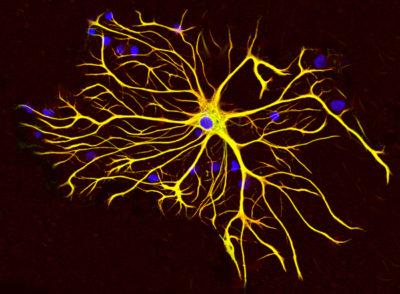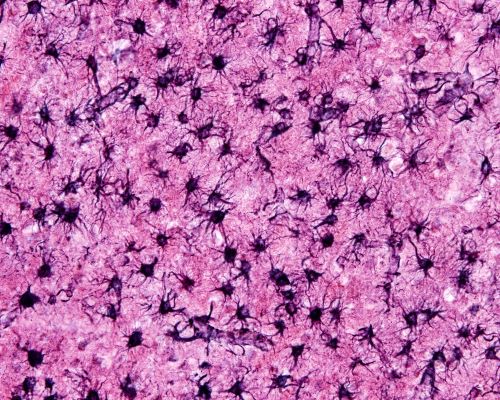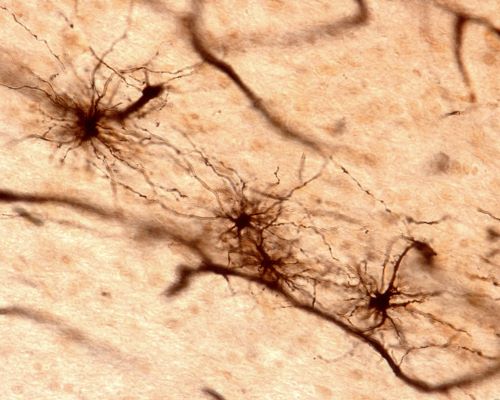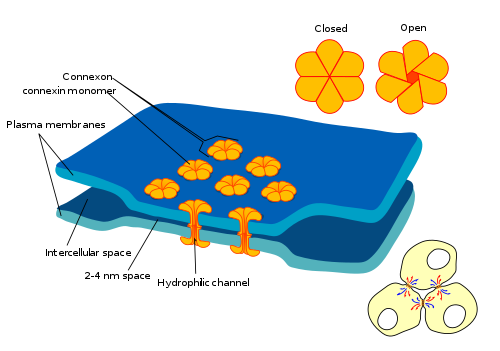Brain glucose metabolism
In the absence of starvation, cells of the brain rely entirely on blood glucose for energy. The brain represents only 2% of the body’s total mass, but it consumes 20% of the body’s oxygen and glucose to make ATP. While both neurons and astrocytes take up glucose from blood, co-operation between astrocytes and neurons in brain glucose metabolism is essential to maximize ATP levels in neurons to support signaling. But first, let’s talk about what astrocytes are and where they are found in the brain?
Brain astrocytes
All central nervous system (CNS) regions are uniformly populated with non-overlapping star-shaped cells named astrocytes.
Astrocytes out number neurons by over five-fold and their turnover rate is low. Astrocytes are divided into two main types, protoplasmic astrocytes and fibrous astrocytes. Protoplasmic astrocytes are in brain’s gray matter among the neuron cell bodies. Protoplasmic astrocytes have several stem-like branches that give rise in turn to many finely branching processes that form a globe-like structure. In the adult brain, in the gray matter of the hippocampus and cortex many finely branching processes from a single protoplasmic astrocyte are estimated to contact up to 600 dendrites of multiple neurons enveloping 100,000 or more synapses.
in contrast, fibrous astrocytes are found in brain white matter among the neuron axon pathways. Fibrous astrocytes appear as an assembly of long filaments. Fibrous astrocytes in the white matter of the brain contact neuron axons at the non-myelinated Nodes of Ranvier. Both types of astrocytes also make extensive contact with blood arterioles and capillaries.
Brain neuron synapse
Some protoplasmic astrocytes blanket brain synapses so closely that they contribute to a structure called the ‘tripartite synapse’. The three participants at these synapses are a presynaptic neuron’s terminus, a postsynaptic dendrite and an astrocyte process.
At this type of brain neuron synapse, astrocytes receive neurotransmitter input at their plasma membrane proteins. Expression of specific neurotransmitter binding proteins on astrocyte plasma membrane is matched to the neurotransmitter released in their immediate environment.
This arrangement allows astrocytes to monitor activity and energy needs of the neurons it is supporting, and to maintain the fluid, ion, and pH level of the synaptic interstitial fluid. All these set points are critical for brain homeostasis.
Astrocyte function
Another important feature of astrocyte structure is that the most distal tips of their long processes can meet and become linked by gap junctions. Gap junctions directly link the cytoplasm of multiple astrocyte cells forming a brain network through which ions and molecules can pass between cells.
In various parts of the brain, large cellular networks of astrocytes can reach a millimeter in size and include hundreds to thousands of astrocytes. Astrocyte networks are organized into anatomical and functional compartments in different brain areas like neuron networks.
Brain energy
A major role played by astrocytes is to capture nutrient molecules from blood and convert them to a form that supports the high energy needs of neuronal synapses. Both astrocytes and neurons can take up glucose from blood. However, it is astrocytes that regulate blood flow to neurons. They do this by releasing molecules that cause either vasoconstriction or vasodilation of the blood vessels.
Only astrocytes can store the glucose they extract from blood in the form of glycogen. Glycogen breakdown at times of intense activity or fasting provides much needed glucose. However, the energy management system at work between neurons and astrocytes is more complicated than mere uptake and storage of glucose.
The best studied system for energy management in brain is the dynamic collaboration between astrocytes and excitatory glutamate neurons. Glutamate is the major neurotransmitter of the awake brain. Glutamate released at neuronal synapses is mainly retrieved from the synapse by astrocytes rather than by the neurons.
The primary astrocyte glutamate transporters in human brain are the ATP dependent Na+/glutamate co-transporters EAAT1 and EAAT2. These two transporters consume ATP and co-transport 1 glutamate molecule with 3 Na+ ions into astrocytes, an energy expensive process. To compensate for the loss of glutamate from the neuron, astrocytes synthesize glutamine de novo from pyruvate, the final product of glucose breakdown in the cytosol. They then export the glutamine to the neuron.
About 1/3 of glutamate taken up by astrocytes is also converted to glutamine by astrocytes and returned to the neuron. Within the neuron glutamine is converted to glutamate and repackaged into vesicles for synaptic release. One theory is that this arrangement provides an energy advantage for neurons. The uptake of glutamate from the synapse is an energy expensive process. Also, the de novo synthesis of glutamate requires a drain of intermediates from the tricarboxylic acid (TCA) energy cycle in mitochondria.
Without TCA cycle intermediates the amount of ATP that can be made from glucose by the neuron is reduced. A neuron in this co-operative arrangement with astrocytes maintains its TCA energy cycle components and can use all its own glucose for aerobic ATP production.
Fibrous astrocytes
White matter fibrous astrocytes make extensive contact with blood vessels and form networks with gap junctions. They supply glucose to the axon and maintain extracellular fluid properties of the white matter. White matter fibrous astrocytes are located close to oligodendrocytes that wrap the axons, and they have different tasks than brain gray matter protoplasmic astrocytes surrounding neuronal dendrites.
The energy demand of white matter of the brain, the neuron axon pathways, is much lower than that of brain gray matter, neuron cell clusters. Some studies have measured differences in energy demand between these two regions as high as 12-fold. This means that the protoplasmic astrocytes, rather than the fibrous astrocytes, are the major regulators of brain glucose metabolism.
Further Reading
Do you have questions?
Please put your questions in the comment box or send them to me by email at DrReece@MedicalScienceNavigator.com. I read and reply to all comments and email.
If you find this article about the important role played by astrocytes in the brain helpful, share it with your fellow students or send it to your favorite social media site by clicking on one of the social media buttons.
Margaret Thompson Reece PhD, physiologist, former Senior Scientist and Laboratory Director at academic medical centers in California, New York and Massachusetts is now Manager at Reece Biomedical Consulting LLC.
She taught physiology for over 30 years to undergraduate and graduate students, at two- and four-year colleges, in the classroom and in the research laboratory. Her books “Physiology: Custom-Designed Chemistry”, “Inside the Closed World of the Brain”, and her online course “30-Day Challenge: Craft Your Plan for Learning Physiology”, and “Busy Student’s Anatomy & Physiology Study Journal” are created for those planning a career in healthcare. More about her books is available at https://www.amazon.com/author/margaretreece. You may contact Dr. Reece at DrReece@MedicalScienceNavigator.com, or on LinkedIn.
Dr. Reece offers a free 30 minute “how-to-get-started” phone conference to students struggling with human anatomy and physiology. Schedule an appointment by email at DrReece@MedicalScienceNavigator.com.






